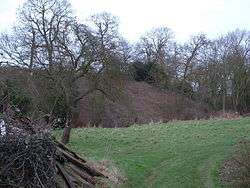Buckenham Castle
| Buckenham Castle | |
|---|---|
| Old Buckenham and New Buckenham, Norfolk | |
|
Earthworks at New Buckenham | |
 Buckenham Castle | |
| Coordinates | grid reference TM08429041 |
| Site information | |
| Condition | Earthworks survive |
Old and New Buckenham Castle are two castles in the adjacent villages of Old Buckenham and New Buckenham, Norfolk, England.
Old castle
All that remains today of what was a Norman castle are the remnants of the earthworks and some traces of a stone curtain wall. The castle was built by William d’Albini, a follower of William the Conqueror. After the castle was moved to the new site a priory was established on the site thus destroying many of the earlier remains.
To service the castle and garrison, what is now New Buckenham was established and it is thought that it probably covered much the same area and grid layout as remains today. In recent centuries however the village has greatly expanded on all sides, leaving the remains of the original community traceable at the centre. Many dwellings of all sizes have expanded the village in all directions, and since the 1960s the village has grown especially to the North, with a housing development, village hall and playing fields, cemetery and allotments all outside of the suggested earlier community.
New castle
Because the parish boundary is to the East of the castle remains, close to the village of New Buckenham, the ruins of the castle, the earthworks, the chapel/ barn and most of the surrounding meadows/ scheduled land are in fact in Old Buckenham, and should correctly be known as Old Buckenham Castle. The Village of New Buckenham came after the castle.
In the early part of the reign of King Stephen a new castle was built two miles to the north west of the site of the old castle by the Aubigny family. Today we can still see the remaining foundations of a circular stone keep - this is approximately 60 feet in diameter. The castle was besieged during the Barons' War in 1263. The fortress was finally demolished in 1649 by the owner Sir Philip Knyvet, leaving just the moat and the earth ramparts.
The Knyvett family had moved here from their earlier seat at Southwick, Northamptonshire. By 1465 Sir John Knyvet occupied the castle. That year his daughter, Christiana, married Sir Henry Colet, later Lord Mayor of London.[1]
The castle comprised an inner bailey and two outer baileys, all with earth walls. The circular keep is thought to be the earliest in England. Its walls are 11 feet thick at their base and it is thought that the height of the keep in its heyday could have been as much as 40 feet.
The castle ruins are located in Old Buckenham parish although actually on the edge of the village of New Buckenham ( - this some 15 miles south-west of Norwich on the A11 and the B1077.
This site is a Grade I Listed building and a Scheduled Monument.
The key is available from Castle Hill Garage [2] - There is a small admission charge.
See also
References
- ↑ Anne F. Sutton, ‘Colet, Sir Henry (c.1430–1505)’, Oxford Dictionary of National Biography, Oxford University Press, 2004
- ↑ "Archived copy". Archived from the original on 2010-08-27. Retrieved 2010-04-13.
- Remfry, P.M., Buckenham Castles, 1066 to 1649 (ISBN 1-899376-28-3)
External links
Coordinates: 52°28′18″N 1°04′02″E / 52.4718°N 1.0672°E
